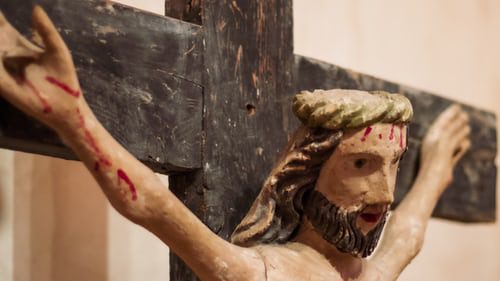
Holy Week Highlights
We are now experiencing the season of Lent, which will soon transition into Holy Week. I thought this would be the perfect time to revisit what happened during Jesus’s last week of ministry. The biblical accounts of Holy Week are interspersed throughout the Gospels: Matthew 26-28, Mark 11, 15-16, and Luke 19, 22-24.
Palm Sunday
Holy Week begins with the triumphal entry of Jesus into Jerusalem. This is the only time Jesus permitted a public demonstration of His arrival and presence. In doing so, Jesus achieved two things: 1) He fulfilled the prophecy to present Himself as the king of Israel, and 2) He forced the religious leaders to act.
His entry on a colt symbolized royalty. The donkey was considered a royal animal of Jewish monarchs. The colt, accompanied by its mother, had never been ridden. This further indicates Jesus’s sovereignty over creation. Coats, blankets, and palm branches were thrown before Jesus as a royal reception in Jewish tradition.
The Passover crowd, upwards of two million, were Jews from Jerusalem, people from Galilee, and followers who had seen Jesus raise Lazarus from the dead. Many thought Jesus was coming to rid Roman rule and establish His glorious kingdom.
The plot to kill Him was already set. The timing just needed to be right.
Monday
Jesus entered the city early that morning, weeping openly upon his approach. He knew the terrible judgment that was coming. He arrived at the Temple, seeing the court filled with corruption. The Temple courtyard was the only place available to Gentiles. It was here that the Jews could witness to them about the one true living God. But now, it had become a marketplace with money changers making profits for their business and sharing it with the priests. Jesus cleared out the Temple once before, three years earlier.

Tuesday
The religious leaders were upset in the aftermath of Jesus’s anger in the Temple court. They felt threatened. Who was this Jesus establishing Himself as a spiritual authority? They tried to ambush Him. Jesus addressed them as “blind guides, snakes, and sons of vipers!”
That afternoon, Jesus took His disciples to the Mount of Olives. He delivered the Olivet Discourse, a prophecy regarding the destruction of Jerusalem and the end of the age. Jesus answered many questions using parables and symbols. Many scholars believe this was the equivalent to examining the lamb chosen for Passover to ensure it had no blemishes. As the sacrificial Lamb of God, Jesus was scrutinized by His enemies, who found no fault in Him.
One of the disciples, Judas Iscariot, negotiated a deal with the Sanhedrin, the religious court of Israel.
Wednesday
The Bible does not specifically mention anything about this day. However, after two jam-packed days in Jerusalem, Jesus and His disciples may have spent the day resting in the nearby city of Bethany.
Thursday
On this fifth day of Holy Week, a somber pivot takes place. Jesus sends Peter and John ahead of Him to prepare for the Passover Feast. This day is known as Maundy Thursday, meaning “commandment.” Jesus washed the feet of His disciples, demonstrating agape love as the new commandment. Sacrificial and humble service to others is shown.
During the Passover Meal (Last Supper), the institution of communion (Lord’s Supper) was established using the bread and wine as Jesus’s body and blood as a remembrance of His sacrifice. He was, after all, about to be the sacrificial lamb (Lamb of God). The betrayal of Jesus by Judas Iscariot was called out.
Following the meal, they departed from the Upper Room and went to the Garden of Gethsemane. Jesus earnestly prayed to “let this cup pass from me” if at all possible. Judas showed up with Roman soldiers, identifying Jesus with a kiss. Jesus was arrested and taken to the home of the High Priest, where the council of the Sanhedrin awaited. An unlawful trial began.

Friday
Good Friday commemorates the most painful and difficult day of Holy Week. Jesus endured ridicule, condemnation, mockery, torture, and abandonment. After multiple trials, He was sentenced to death by one of the most horrible and disgraceful means of death: crucifixion.
Jesus was flogged and beaten almost beyond recognition. A crown of thorns was pressed into his skull. Then He was forced to carry his heavy cross on which He was nailed. He died an excruciating death, but not one bone was broken. A spear was thrust into His side. Since He died within a surprising six hours, Jesus’s legs remained intact and unbroken by Roman soldiers.
The body of Jesus was removed and laid in a rich man’s tomb.
Saturday
Roman soldiers guarded the tomb. Jesus’s body was ceremonially treated for burial with 75 pounds of spices purchased by one of the Sanhedrin members who had secretly followed Him.
Then came Resurrection Sunday!

8 Comments
Leave a Comment
Follow This Blog
Ewe R Blessed Ministries / Karen O. Allen

Good reminder of the events that led up to the resurrection. Easter is a special time of the year.
Lots of activity during Holy Week for sure.
Gloryyyyyy my good sister. Thank you for this good insight into the power of Easter
I appreciate that, Chaplain Eddie. I really enjoyed putting it together, learning stuff in the process.
Thanks, Karen, for this! I have copied it and placed it among my devotional materials as a quiet time guide to the events of Holy Week!
Way cool, Dr. Luellen. Glad I could enhance your quiet time.
Easter blessings, Karen.
You as well, Diana.